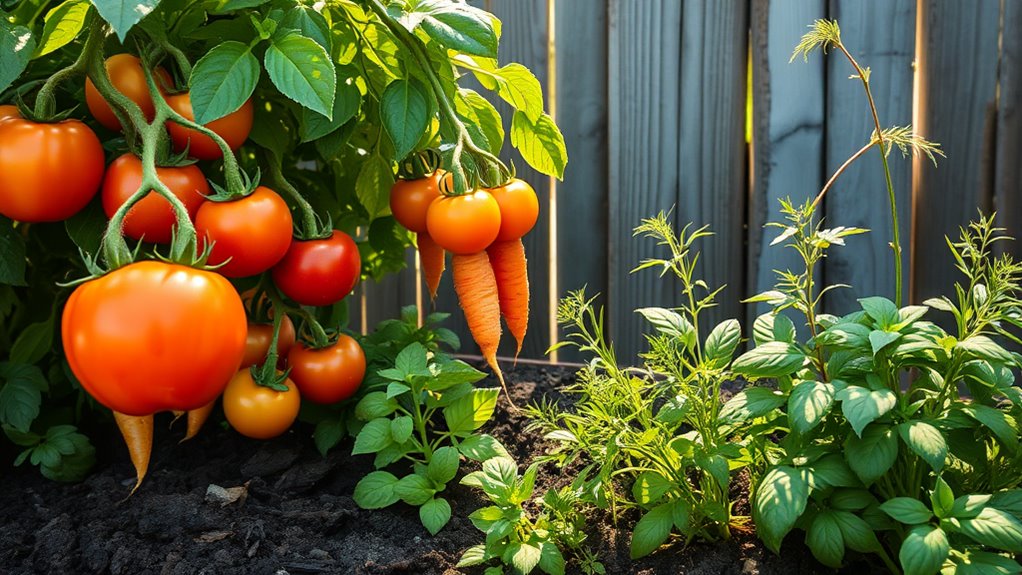The Secret to Growing Veggies That Actually Taste Better
Just as a fine wine owes its flavor to the soil where the grapes are grown, the taste of your vegetables largely depends on the conditions in which they thrive. You might think that any garden can yield delicious produce, but there are specific practices that can transform ordinary veggies into spectacular culinary delights. From selecting the right varieties to understanding companion planting, let’s explore how you can enhance the flavor of your harvest.
Selecting the Right Varieties
When you’re ready to start your vegetable garden, selecting the right varieties is crucial for your success.
Consider your climate, space, and taste preferences. Look for disease-resistant types and those suited to your growing conditions.
Don’t forget to gather vegetable growing tips from local gardeners or gardening clubs to help you choose flavorful, high-yielding varieties that thrive in your environment. Additionally, planting some best spring plants can enhance soil health and provide nutrients for your vegetable garden.
Soil Health and Nutrient Management
While many gardeners focus on choosing the right vegetable varieties, neglecting soil health can lead to disappointing results.
You’ll want to enrich your soil with organic matter, such as compost or well-rotted manure, to improve structure and nutrient content.
Regularly test your soil pH and nutrient levels, adjusting with amendments like lime or fertilizer, ensuring your veggies have the essentials they need for better flavor. Additionally, incorporating poor garden soil amendments can transform problem areas into thriving growth spots.
Optimal Watering Techniques
How can you ensure your vegetables thrive while using water efficiently?
Water deeply and less frequently, encouraging roots to grow downwards. Early morning is the best time for watering, reducing evaporation.
Use soaker hoses or drip irrigation for targeted watering. Monitor soil moisture, and adjust based on weather conditions. Implementing a consistent watering schedule will also help prevent issues related to overwatering or underwatering.
Consistency is key; aim for a regular watering schedule to promote healthy growth.
Sunlight and Plant Placement
To ensure your vegetables flourish, you need to consider both sunlight and plant placement carefully. Aim for at least six hours of direct sunlight daily.
Position taller plants to the north, providing shade for shorter ones. Use raised beds or containers to maximize exposure.
Regularly observe light patterns in your garden; adjust placements as needed to ensure all plants receive adequate sunlight. Additionally, utilizing organic fertilizers can significantly enhance growth and improve the taste of your vegetables.
Companion Planting Strategies
Maximizing your garden’s potential goes beyond just sunlight and placement; companion planting offers a way to enhance growth and deter pests naturally.
Consider these strategies:
- Pair tomatoes with basil to boost flavor and growth.
- Plant marigolds near veggies to repel harmful insects.
- Grow beans alongside corn for nitrogen fixation and support.
Using these companions can lead to a healthier, tastier harvest. Additionally, incorporating companion planting benefits into your garden can create a thriving ecosystem that supports plant health and productivity.
Timing Your Planting and Harvesting
While the excitement of planting a new garden can be contagious, knowing when to plant and harvest your vegetables is essential for achieving a successful yield. Here’s a simple guide to help you time your planting perfectly:
| Vegetable | Best Harvest Time |
|---|---|
| Tomatoes | Late summer |
| Carrots | Early summer |
| Lettuce | Spring/Fall |
| Cucumbers | Mid-summer |
| Bell Peppers | Late summer |
Watering your plants at the right time is crucial for their optimal growth, especially during the critical stages of development.

